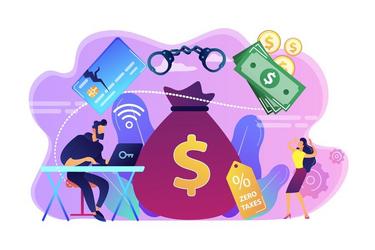Attractiveness for money laundering
The anonymity[1] and global reach of cryptocurrencies[2] have made them attractive for money laundering[3] activities. While the vast majority of cryptocurrency[4] transactions are legitimate, the inherent features of digital currencies[5] can be exploited by individuals looking to obscure the source of illicit funds. This challenge has prompted regulatory bodies worldwide to implement measures aimed at curbing the use of cryptocurrencies for money laundering.
- Mechanisms of Money Laundering in Crypto
- Regulatory Efforts to Combat Money Laundering
- Challenges in Preventing Money Laundering
- The Future of Anti-Money Laundering Measures
- Attractiveness for money laundering
- Anonymity and Privacy
- Decentralized Nature
- Cross-Border Transactions
- Complexity and Technical Challenges
- Use of Mixers and Tumblers
- Regulatory Arbitrage
- Emerging Technologies and Innovations
Mechanisms of Money Laundering in Crypto
Criminals may use various methods to launder money through cryptocurrencies, including the use of mixing services[6], which obscure the origins of funds, and moving funds through multiple cryptocurrencies and wallets to evade detection.
Regulatory Efforts to Combat Money Laundering
In response to the risk of money laundering, regulatory agencies have begun to enforce stricter regulations on cryptocurrency exchanges and wallet[7] providers. These include the requirement for Anti-Money Laundering (AML) programs, Know Your Customer (KYC) procedures, and reporting of suspicious activities.
Challenges in Preventing Money Laundering
Despite regulatory efforts, the decentralized nature of cryptocurrencies presents significant challenges in monitoring and preventing money laundering. The pace of technological innovation often outstrips the development of regulatory frameworks.
The Future of Anti-Money Laundering Measures
The ongoing development of blockchain[8] analysis tools and international cooperation among regulatory bodies are critical to enhancing the effectiveness of anti-money laundering measures in the cryptocurrency industry.
Attractiveness for money laundering
Blockchain technology, with its innovative approach to security, transparency[9], and decentralization[10], has revolutionized numerous industries. However, its features also present a double-edged sword by offering attractive avenues for illicit activities, particularly money laundering. Understanding how blockchain can be misused for such purposes requires a deep dive into its inherent characteristics and the challenges they pose for regulatory and enforcement agencies.
Anonymity and Privacy
Blockchain technology provides enhanced privacy features, including pseudonymity in transactions. Users can conduct financial exchanges without revealing their true identities, using only cryptographic addresses. This level of anonymity is appealing for money laundering, as it complicates the task of tracing illicit funds back to their original sources. While privacy is a legitimate concern for users seeking protection from surveillance and data breaches, it also creates a shield for those looking to obscure the origins of illegally obtained money.
Decentralized Nature
The decentralized structure of blockchain means there is no central authority or intermediary overseeing transactions. This aspect is fundamentally what makes blockchain so innovative, removing the need for traditional financial institutions in transactions and thereby reducing associated costs and time delays. However, this same feature makes it difficult for regulatory bodies to monitor and control financial flows, offering a loophole for laundering money through a web of international transactions without oversight.
Cross-Border Transactions
Blockchain enables fast and efficient cross-border transactions, allowing funds to move globally with fewer restrictions and lower costs than traditional banking systems. While this facilitates legitimate international business and remittances, it also opens the door for money launderers to transfer large sums across borders quickly and without detection, exploiting differences in national regulatory frameworks and enforcement capabilities.
Complexity and Technical Challenges
The technical complexity of blockchain technology can be a barrier to understanding and monitoring by regulatory authorities. With the constant evolution of blockchain platforms and the emergence of new cryptocurrencies, keeping up with the technical nuances and developing effective oversight mechanisms is a significant challenge. This complexity provides a fertile ground for sophisticated money laundering schemes that exploit gaps in knowledge and regulatory lag.
Use of Mixers and Tumblers
Services known as mixers or tumblers increase the attractiveness of blockchain for money laundering. These services obfuscate the trail of cryptocurrency transactions by mixing potentially identifiable or “tainted” funds with others, making it extremely difficult to trace the original source. While these services can be used for privacy-enhancing purposes, they also offer a powerful tool for laundering money by breaking the link between the funds and their illicit origins.
Regulatory Arbitrage
The fragmented regulatory landscape[11] for cryptocurrencies and blockchain technology allows for regulatory arbitrage, where individuals or entities exploit differences in regulations across jurisdictions. Money launderers can move their operations to countries with lax cryptocurrency regulations or those with gaps in enforcement, further complicating international efforts to combat money laundering.
Emerging Technologies and Innovations
The continuous innovation in blockchain and cryptocurrency technologies, such as the development of privacy coins which enhance anonymity beyond that of Bitcoin[12] and other first-generation cryptocurrencies, presents ongoing challenges. These innovations can potentially offer even more sophisticated means to launder money, outpacing regulatory and technological efforts to prevent misuse.
In conclusion, while blockchain technology heralds a new era of financial and digital innovation, its very features that promote efficiency, privacy, and decentralization also make it attractive for money laundering. Balancing the benefits of blockchain with the need to prevent its misuse for illicit activities is a complex challenge, requiring ongoing collaboration between technology experts, regulatory bodies, and international organizations.
- Anonymity — The ability to maintain privacy over transaction and identity details within cryptocurrency transactions.
- Cryptocurrencies — Digital or virtual currencies that use cryptography for security and operate on a decentralized system, unlike traditional currencies.
- Money Laundering — The process of making large amounts of money generated by a criminal activity appear to be legally obtained.
- Cryptocurrency — Digital or virtual currency secured by cryptography, facilitates secure, anonymous transactions.
- Digital currencies — Digital forms of money that exist only in electronic form, not in physical form like coins or notes.
- Mixing Services — Services that mix cryptocurrency funds to obscure the trail back to the funds' original source.
- Wallet — A digital tool that allows users to store and manage their cryptocurrency addresses.
- Blockchain — A decentralized digital ledger recording cryptocurrency transactions across multiple computers.
- Transparency — The characteristic of blockchain technology that allows all transactions to be visible and verifiable by all network participants.
- Decentralization — Distribution of power away from a central authority in the management of cryptocurrencies.
- Regulatory Landscape — The set of laws, guidelines, and policies that govern the use of virtual assets across different regions.
- Bitcoin — The first and most well-known cryptocurrency, was introduced in 2009 by Satoshi Nakamoto, who developed Bitcoin.
- Financial Action Task Force (FATF). 'Guidance for a Risk-Based Approach to Virtual Assets and Virtual Asset Service Providers', 2019.
- Chainalysis. 'The 2020 State of Crypto Crime', 2020.


